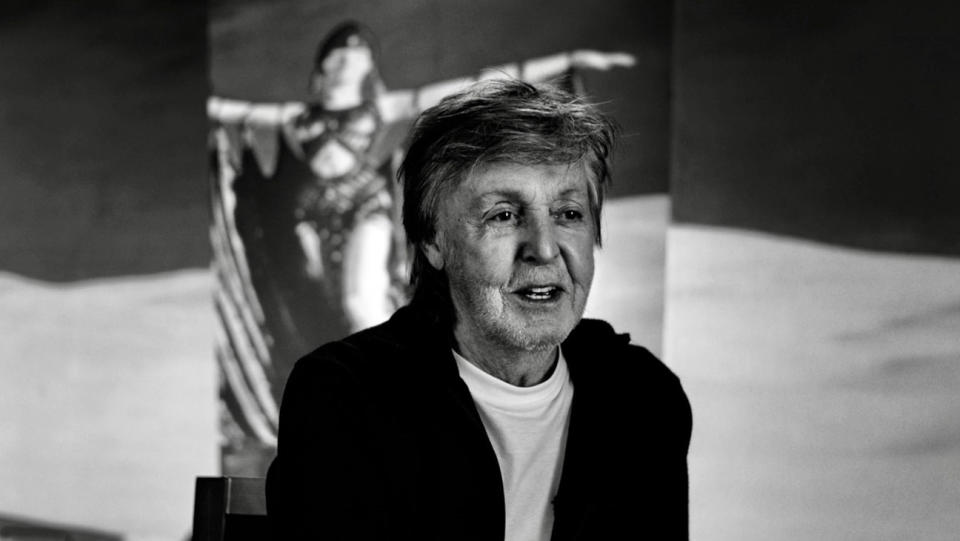Critic’s Notebook: A Generation’s Chords of Celebration, Elegy and Reckoning Resound in Two New Brit-Rock Docs
- Oops!Something went wrong.Please try again later.
- Oops!Something went wrong.Please try again later.
- Oops!Something went wrong.Please try again later.
- Oops!Something went wrong.Please try again later.
- Oops!Something went wrong.Please try again later.

Well after their deaths, the pop stars of an earlier era — the mid-20th century, to be precise — are receiving documentary treatment, such greats as Ella Fitzgerald, Dean Martin and Louis Armstrong among them. Artists of the baby boom, on the other hand, a generation of unprecedented size and many other firsts, are participating in the process, as they have been for decades.
The earliest documentary portraits of boomer musicians set the bar high with a fresh, self-reflexive power. D.A. Pennebaker’s 1967 Don’t Look Back traced Dylan’s ambivalent dance into and out of the spotlight, and in 1970 the Maysles brothers’ Gimme Shelter found the Rolling Stones facing darker complexities around the same push-pull. Today, films exploring pop artists’ life’s work, or at least certain aspects of it, are being made while they’re still engaged in it.
More from The Hollywood Reporter
Guest Column: How Greta Gerwig's 'Barbie' Tends to Her Superpowers
Tony Bennett, the Gold Standard of Singers Everywhere, Dies at 96
Two of the most captivating and poignant documentaries to hit screens so far this year focus on the legacy of key creative forces in the rock era who are no longer with us, but whose friends and collaborators, most of them nearing 80 or beyond, are here to bear witness. The films reverberate with elegiac chords that are specific to the biographies of a couple of beloved and challenging men, but they also resound with the joys and heartaches of a generation looking back, taking stock.
The docs form a striking Venn diagram, weaving intimate rock ’n’ roll histories around a core of shared DNA: the members, past and present, of Pink Floyd, and a less well-known figure who played a critical role in the band’s career. He was a visual artist and mad conceptualizer named Storm Thorgerson who, with Aubrey Powell, created a London art design studio called Hipgnosis and many of the most adventurous and indelible album covers of the late ’60s and ’70s. It was a time when album covers mattered.

Thorgerson, who died in 2013 at 69, is at the center of Anton Corbijn’s Squaring the Circle (The Story of Hipgnosis), which opened in June. And he’s the impassioned offscreen interlocutor and the co-director, with Roddy Bogawa, of Have You Got It Yet? The Story of Syd Barrett and Pink Floyd, which bows stateside this week.
Barrett was the electric spark who named Pink Floyd and led his bandmates into formula-shattering musical territory. Within a few busy years he wrote the group’s first two hits and then became, by all accounts, an acid casualty. By mutual agreement he didn’t join the band on its chart-climbing road to stardom. Barrett, who died in 2006, at age 60, after decades of mysterious reclusion, never had any interest in explaining himself. Thorgerson, often brash and annoying, didn’t play by the rules either.
Rock ’n’ roll mythologizing is one of the subjects of Squaring the Circle and Have You Got It, but it’s not their method. Rather than reaching for a neat or aggrandizing summing-up, they grapple with the passage of time and the perspective it brings. The films’ subjects and interviewees belong to the first wave of baby boomers, and the filmmakers belong to the younger cohort of that group, aka Generation Jones — the kids who missed hippiedom by a few years but still absorbed the countercultural idealism. The kids who bought the albums.
Friends of Barrett and Thorgerson — among them Powell, Pink Floyd’s Roger Waters, David Gilmour and Nick Mason, Led Zeppelin’s Robert Plant and Jimmy Page — offer clear-eyed recollections, not self-congratulatory nostalgia. There are difficult memories along with the fond ones, and sometimes a sense of still being slightly amazed. Fifty years after Paul McCartney rang up Hipgnosis about a Wings cover, Powell’s eyes sparkle with delight as he relates the thrill of “working for a Beatle.” It’s the elation of a true fan.
These are stories of finding your people. Before becoming business partners, Powell and Thorgerson bonded like brothers. Before Barrett, Waters, Mason and Richard Wright (who died in 2008) embarked on the uncanny experiment of building a band, Thorgerson and Barrett met as teens. They were both leading lights in a vibrant bohemian scene that began in Cambridge and then moved its explorations of painting, music, film and drugs to London — when it was “lawless,” as Powell recalls, not to mention affordable. These are stories of creative alchemists, a vanguard rejecting conventional notions of career and forging a cultural revolution.
Approaching an epochal moment from intersecting angles, Squaring the Circle and Have You Got It feel like complementary parts of a whole. Their conversations overlap and echo each other — and they’re certainly part of a larger one, unfolding in a crop of recent nonfiction work that showcases a remarkable period of musical innovation. Two docuseries, Asif Kapadia’s 1971 and Peter Jackson’s The Beatles: Get Back, delve into rich archives with exhilarating results, as does Ahmir “Questlove” Thompson’s feature doc Summer of Soul. On a more straightforward note of celebration, Mary McCartney’s If These Walls Could Sing pays tribute to London’s Abbey Road Studios, a crucial element in the history of modern music as a whole and in many a band’s story, including Pink Floyd’s.
The quartet recorded its first album there at the same time that Mary McCartney’s father, Sir Paul, and his fellow Beatles were in the next-door studio, working on Sgt. Pepper’s, their landmark concept album. A few years later, well after Barrett and Pink Floyd had parted ways, the group’s onetime leader made a sudden, heartbreaking appearance at Abbey Road while the band was recording Wish You Were Here. Given that Barrett’s absence is one of the album’s themes, his timing was eerie. He was all but unrecognizable, his youthful energy gone.

A moving and complex homage to Barrett, Bogawa’s film also turned out to be his “goodbye to Storm,” who was ill with cancer during its making. It’s an appreciation and a reckoning, as is Squaring the Circle, the first feature documentary by Corbijn, a prolific music video director whose 2007 film Control, centering on the short life of Joy Division’s Ian Curtis, is an exceptional rock biopic. Unlike Curtis, the interviewees in Squaring the Circle, embraced in the black-and-white cinematography’s rich play of light and shadow, are figures of longevity.
There was magic in the way Britain’s working-class kids, coming of age in a country ready to shake off the gloom and devastation of World War II, looked across the Atlantic for inspiration (Barrett named the band after Pink Anderson and Floyd Council, two little-known Southern blues musicians) — and in the ways they translated their excitement back to American youth through newfangled distillations of pop and rock and psychedelia.
Powell and Thorgerson created imagery in communion with the music, not the marketing department. “They became a part of us,” Plant says. To the chagrin of the labels, Hipgnosis’ concepts weren’t about branding in the old-fashioned sense — good luck finding a band’s name or photo on many of the album covers.
Among the visions they dreamed up and produced, sans Photoshop: otherworldly children clambering over the Giant’s Causeway on Led Zeppelin’s Houses of the Holy, the caught-in-the-searchlight convicts on Wings’ Band on the Run, the potent graphic simplicity of a stylized prism on The Dark Side of the Moon. That 1973 Pink Floyd album would be a career-making breakthrough for both the band and for Hipgnosis, whose grungy office on Denmark Street was a mecca for ideas that reconfigured the music-biz dynamic between art and commerce.
As the records sold and the money flowed, the musicians and the designers could call the shots, and over time Hipgnosis’ daring practical effects took on an almost parodic excess. There was the Valium-dosed sheep on a psychiatrist’s couch in the Hawaiian surf for a 10cc album, and the need to shut down Heathrow flight lanes when Pink Floyd’s giant inflatable pig escaped its moorings. There was the trip to the Alps to grab a shot of a statuette on a snowy mountaintop for Paul and Linda McCartney. Is it any wonder that punks would arise to pounce on the “dinosaurs” of the music business? Or that Generation Jones, caught between the boomer vanguard and Gen X’s ironic detachment, might unapologetically enjoy both the megastars and the punks?

For those who grew up in a pre-digital, pre-MTV age, the importance of the album cover cannot be overstated. The design and imagery and liner notes, the gatefold (if there was one!), the lyric sheet (ditto!), all of it was part of the album’s narrative. It didn’t have to be a full-on rock opera à la The Who’s Tommy to feel like something ineffably cohesive — a collection of short stories in the form of songs, or an aural suite with a novel’s arc.
Even within their basic formats, pairing archival material with talking heads, Have You Got It Yet? and Squaring the Circle have a novelistic sweep. They’re fueled by deep affection and, like many love stories — many life stories — shaped by regret and grief. One film begins in an ancient cemetery, the other closes with an In Memoriam sequence, and they both culminate in a quiet surge of intense emotion. These are stories of finding your people, yes, but not everyone could maintain the bond.
In Corbijn’s film, Powell weeps over the rift that kept him and Thorgerson apart for more than a decade. In Bogawa’s doc, Barrett’s sister, who cared for him after what might have been a psychotic break induced by heavy use of LSD, holds back tears and sees only a cautionary tale, while Gilmour wishes aloud that he’d visited Barrett during his long years of seclusion in his childhood home. Waters says he took his troubled former bandmate — “one of the most emotionally and intellectually curious people that I’ve ever met” — to see R.D. Laing, the influential New Left philosopher-psychiatrist. It’s electrifying to contemplate what might have transpired between the author of The Divided Self and the co-founder of Pink Floyd. But when they reached Laing’s, Waters recalls, Barrett refused to get out of the car.
Is Barrett’s story a sad one? Toward the end of Have You Got It Yet?, that’s the question Thorgerson poses to the people who knew him. The thoughtful breadth of answers is inspiring. Barrett was no longer part of the band or the business, but if not for him the psychedelic beauty of The Dark Side of the Moon and Wish You Were Here never would have been. Without Dark Side of the Moon, who knows when lightning would have struck for Hipgnosis. The pieces didn’t all land where and when people might have expected, but the mojo was set in motion. The connections were made, the fuses lighted. It might take the good part of a lifetime to recognize the patterns ignited by serendipity. Sometimes, Pennebaker and Dylan’s warning notwithstanding, there’s wisdom in looking back.
Best of The Hollywood Reporter

